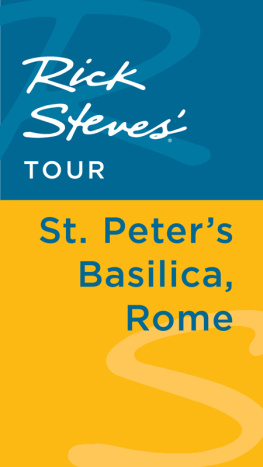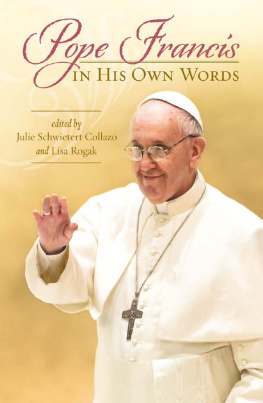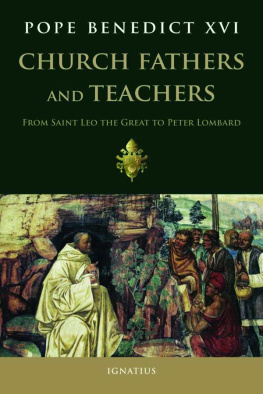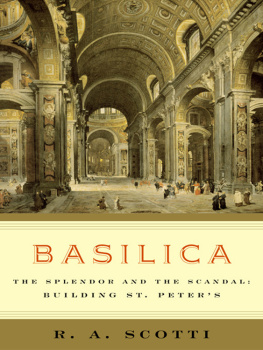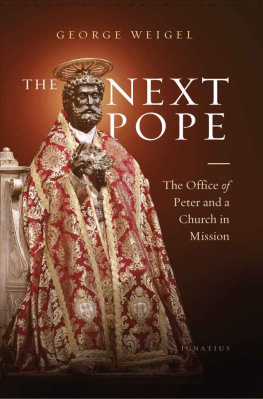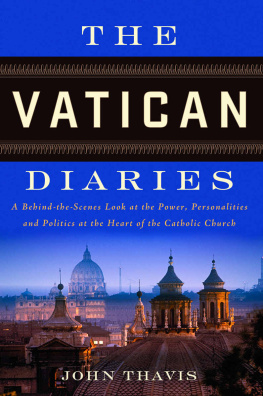Copyright 2013 by Thomas Craughwell
All rights reserved.
Published in the United States by Image, an imprint of the Crown Publishing Group, a division of Random House LLC, a Penguin Random House Company, New York.
www.crownpublishing.com
IMAGE is a registered trademark, and the I colophon is a trademark of Random House LLC.
Library of Congress Cataloging-in-Publication Data is available upon request.
ISBN 978-0-307-98509-5
eBook ISBN 978-0-307-98510-1
Illustrations by Jaclyn Reyes
Cover design by Dan Rembert
Cover photography by Brideman Art Library
v3.1
To my friend and fellow relic wrangler,
Father Charles Jan Di Mascola
CONTENTS
CHAPTER 1:
An Elderly but Powerful Man
CHAPTER 2:
Searching for the Name Peter
CHAPTER 3:
The Catacombs
CHAPTER 4:
Papal Prudence
CHAPTER 5:
Monsignor Kaass Box of Bones
CHAPTER 6:
Painful Facts
CHAPTER 7:
Archaeology Isnt Algebra
A PPENDIX A:
List of Symbols
A PPENDIX B:
What About St. Pauls Bones?
A CKNOWLEDGMENTS
My sincere thanks to the generous, helpful, and patient staff of Image Books, particularly my editor, Amanda OConnor, and my very skillful copy editor, Mary Anne Stewarttheir thoughtful, meticulous editorial work improved this book immeasurably. My thanks to Jessie Bright, who designed the wonderful cover. And finally, a big thank-you to Gary Jansena great friend and my greatest champion at Image Books.
A N OTE ON THE C ULT OF R ELICS
For Catholics and non-Catholics alike, the typical response to relics of the saints tends to alternate between squeamishness and ghoulish fascination. In Europe especially, where it is not unusual to see crystal shrines that display a skull, a tibia, or a femur on altars or in cathedral treasuries, devout pilgrims as well as curious tourists often find themselves uncertain why the Catholic Church permits such a medieval custom to survive.
Of course, displaying and venerating sacred relics is not uniquely a Catholic custom. Christians of the Orthodox Church also preserve and revere relics of the saints. Sacred relics are not unknown among Muslims and Buddhists: Islam has the sword and mantle of the Prophet Muhammed, as well as strands of his beard, while Buddhism preserves bones and teeth of the Buddha.
Reverence for the remains of the saints is older than Christianity. In fact, it is rooted in Scripture, beginning with the Old Testament. There is a story in 2 Kings 13:2021 of an Israelite who was buried beside the body of the prophet Elisha. As his family and friends lowered the corpse into the grave, the dead man brushed against the bones of Elisha; instantly the dead man was restored to life. There are more examples in the New Testament. St. Mark the Evangelist tells of a woman who suffered from a hemorrhage for twelve years. As Jesus walked by her, she reached out and touched the hem of his robeat once, she was healed (Mark 5:2534). Finally, in the Acts of the Apostles, we learn that the first Christians asked St. Paul to touch pieces of cloth, which they carried to those who were seriously ill or possessed by evil spirits. As soon as the infirm came in contact with the cloths Paul had touched, diseases left them and the evil spirits came out of them (Acts 19:1112).
During the first three centuries of the Churchs history, Christians were the targets of sporadic but violent persecution. From the point of view of the Romans, Christians were criminals, enemies of the state who had no respect for Rome, the emperor, or the gods. As criminals they did not deserve honorable burial. It was not unusual for the Roman authorities to burn the bodies of Christian martyrs, then dump the ashes into the nearest river: that was the fate of the bodies of St. Blandina and the other martyrs of Lyon who were put to death in the citys arena in AD 177. Nonetheless, we know that from a very early date Christians made an effort to recover the bodies of the martyrs when possible. In this they were imitating Joseph of Arimathea, a secret disciple of Jesus, who found the courage to ask Pontius Pilate for permission to take Christs body down from the cross and bury it.
A letter dating from about AD 156 is believed to be the oldest surviving account of Christians rescuing the relics of a martyr. During Emperor Marcus Aureliuss persecution of Christians, St. Polycarp, the elderly bishop of Smyrna, was condemned to be burned at the stake. After the fire had burned out and the ashes had cooled, the Christians of Smyrna searched among the cinders. We took up his bones, the anonymous author of the letter wrote, which are more valuable than precious stones and finer than refined gold, and laid them in a suitable place, where the Lord will permit us to gather ourselves together, as we are able, in gladness and joy, and to celebrate the birthday of his martyrdom.
In that one sentence is a summary of how Catholics and Orthodox honor the saints: by placing their remains in a suitable shrine, by treating them as something of inestimable value, and by offering Mass, or the Divine Liturgy, in memory of the saint on the day he or she was born into eternal life in heaven. That anniversary is generally called the saints feast day.
A tradition that dates back to the beginning of the Church in Rome asserts that Christians managed to recover the bodies of St. Peter and St. Paul. Peter was buried in a cemetery on Vatican Hill, near the arena where he had been martyred. Pauls body was buried in a cemetery on the Via Ostiense, the road that ran from Rome to the port of Ostia. At some later date, a shrine was erected over Peters grave, and Pauls bones were placed inside a stone sarcophagus. In AD 199, a Roman priest named Gaius wrote to a man named Proclus, a critic of the Roman Church, saying that if Proclus ever came to Rome, he, Gaius, could show him the tombs of Peter and Paul.
In the year AD 313, the history of Christianity had taken a dramatic turn. The new emperor, Constantine, published an edict that put an end to persecution of the Church, granted legal status to Christianity, and restored to Christians property that had been confiscated from them a decade earlier during Emperor Diocletians empire-wide attempt to obliterate Christianity. Then Constantine went a step further: he favored the Christians above members of every other religion, he gave the popes the Lateran Palace as their residence, and he began an ambitious program of church construction in Rome and the Holy Land.
Some of Constantines basilicasincluding the churches of St. Peter on Vatican Hill, St. Paul on the Via Ostiense, and St. Lawrencewere erected over the tombs of the saints. Then, in AD 386, St. Ambrose, bishop of Milan, discovered the relics of St. Gervase and St. Protase, the first Christian martyrs of his city. Ambrose had the bones moved from their graves in a cemetery and into his cathedral, where the relics would rest in a place of honor. Installing the relics in the cathedral in the heart of town would be more convenient for the Christians of Milan who wished to pray at the resting place of these saints. Ambroses decision marked the next stage in the development of the cult of relicsthe movement (the formal term is translation) of holy remains from a grave in a cemetery to a shrine in a church.
As in the case of the bones of Elisha and the cloths touched by St. Paul, relics often became the vehicle for miracles. In Book 22 of City of God


